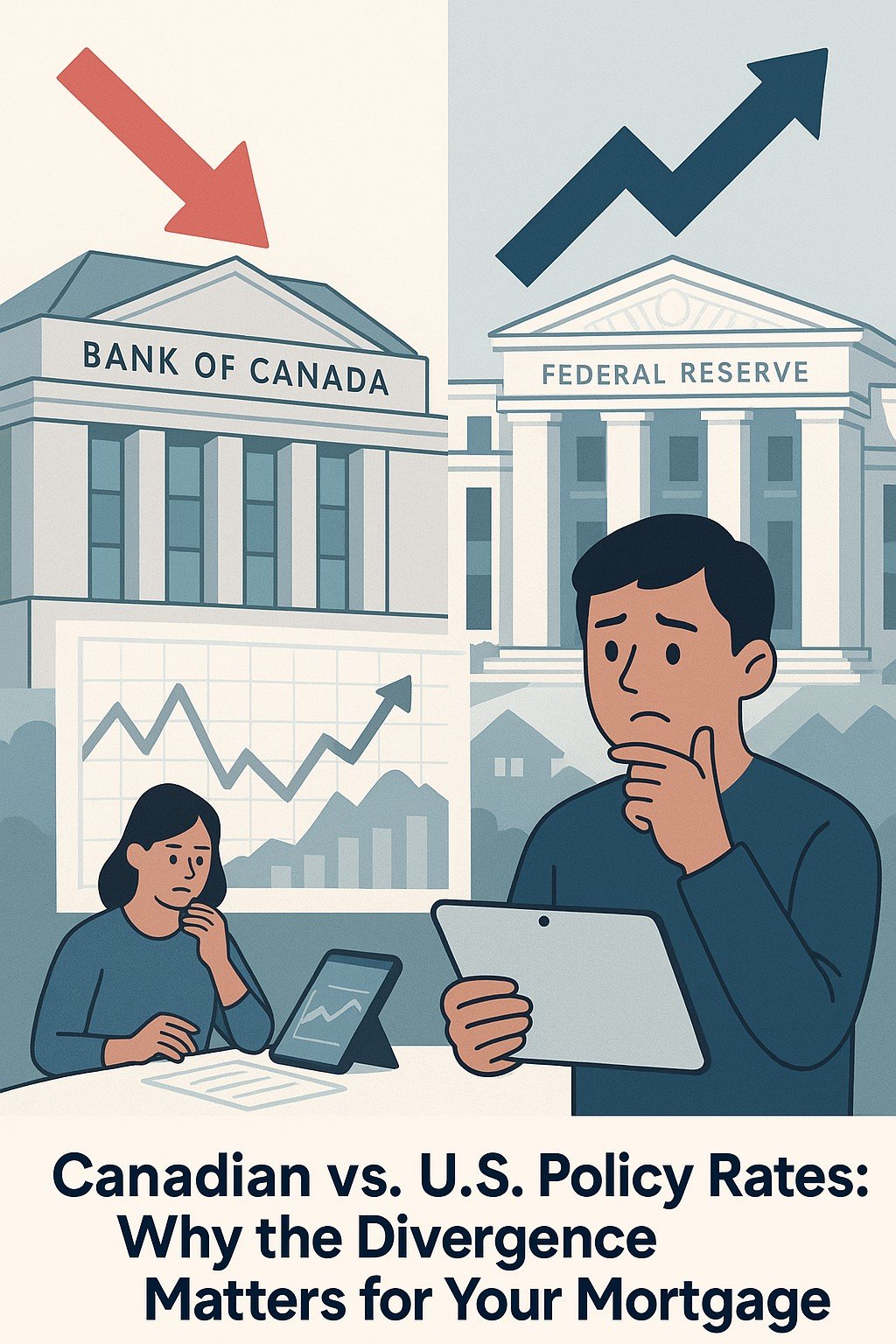
Canadian vs. U.S. Policy Rates: Why the Divergence Matters for Your Mortgage
The Bank of Canada and the U.S. Federal Reserve are taking different paths on interest rates — and it could shape where Canadian mortgage rates go next. Here’s what you need to know.
The Canadian mortgage market is under pressure, and a big part of that story is unfolding quietly across international borders. While the Bank of Canada (BoC) continues to cut rates in an effort to stimulate the economy, the U.S. Federal Reserve is standing still — holding its policy rate steady. This growing policy gap between Canada and the U.S. is creating ripple effects across our currency, borrowing costs, and mortgage market. Let’s break down what’s going on, what it means for you, and how to navigate this high-stakes moment.
When Canada Cuts and the U.S. Holds: What’s Going On? In January 2025, the Bank of Canada announced yet another rate cut, bringing its key policy rate down to 3.00%. That’s the sixth consecutive cut in a series meant to combat sluggish growth, global trade uncertainty, and a weak domestic economy. With that move, Canada officially pivoted from quantitative tightening to a more accommodative stance.
Meanwhile, south of the border, the U.S. Federal Reserve kept its benchmark rate steady between 4.25% and 4.50%. It’s a clear divergence in policy — one that’s driving a wedge between the Canadian dollar and U.S. dollar, and by extension, creating a new set of challenges for Canadian borrowers and the real estate market.
Why the Weakening Loonie Spells Trouble for Mortgages When interest rates diverge between two major economies, their currencies usually follow. In this case, the Canadian dollar has dropped significantly — falling below $0.70 USD in 2024. The reason is simple: lower returns on Canadian assets make the loonie less attractive to investors, which pulls down its value.
But here’s where it gets tricky. A weaker Canadian dollar makes imported goods — from food to building materials — more expensive. That stokes inflation, even while economic growth is slowing. And that awkward mix of inflation and stagnation (aka stagflation) makes it harder for the Bank of Canada to continue with its rate-cutting plan.
So how does this affect your mortgage?
- If you have a variable-rate mortgage, you’ve probably seen your payments drop as the BoC cuts rates.
- But if inflation rebounds due to a weaker loonie, those rate cuts could slow — or even reverse.
- Meanwhile, fixed-rate mortgages are stuck in limbo. Bond markets are volatile, and lenders are being cautious about pricing in the full benefit of rate cuts.
📈 BoC vs Fed Interest Rates
Data: BoC & U.S. Fed official releases
Trade Wars and Tariffs: Another Wild Card As if things weren’t already complicated, trade tensions with the U.S. have entered the chat. President Trump has threatened new tariffs on Canadian goods — up to 25% — starting March 2025. That’s adding more uncertainty, just as the Canadian housing market heads into its spring season.
If these tariffs go into effect, the Bank of Canada expects a noticeable hit to GDP — potentially a 2.4% drop in year one. Inflation would also rise, putting the BoC in a bind: does it cut rates to support growth, or hold them to control prices?
The housing market is already feeling these tremors. While rate cuts typically boost buyer demand, fears of a recession and weaker consumer confidence could mute that effect — especially in expensive markets like Toronto and Vancouver.
What Should Canadian Borrowers Do Now? You don’t need to be an economist to make sense of all this. If you’re a homeowner, buyer, or even just mortgage curious, here’s what matters:
- Variable-rate borrowers: Enjoy the savings while they last — but don’t bank on rates falling much further.
- Fixed-rate shoppers: Timing is tricky. Bond yields may continue to drop, but lender caution could mean slow-to-follow fixed rate reductions.
- Planning a purchase or refinance? You might want to lock in a rate sooner rather than later. Or consider a short-term fixed rate that gives you flexibility if rates shift again.
| Category | 2024 (End of Year) | 2025 (Mid‑June) |
|---|---|---|
| Bank of Canada policy rate | ~3.25% by Dec 11 2024 | 2.75% (held June 4, April, etc.) |
| Canada prime rate | 5.45% (Dec 11 2024) | 4.95% (Mar 13–Jun 4, 2025) |
| Average 5‑year fixed mortgage | ~4.5–4.9% avg late 2024 | ~3.9–4.0% by mid‑2025 |
Final Thoughts: Rate Gaps, Risk, and Real Estate The growing divergence between Canada and the U.S. on interest rate policy is more than just an international finance story — it’s a direct factor in how much you’ll pay on your mortgage, what kind of home you can afford, and whether the market feels like a smart place to jump in.
For a closer look at how diverging rate paths between the Bank of Canada and the U.S. Federal Reserve are influencing Canadian mortgage rates, check out our deep dive on
A personalized mortgage strategy can help you protect against risk, stay nimble in a changing rate environment, and make the most of whatever comes next.
📊 Wondering How These Rate Trends Affect Your Mortgage?
Whether you’re renewing, buying, or refinancing — the BoC vs. Fed rate gap could impact your next move. Let’s help you navigate it with clarity.
💬 Speak to a Mortgage Expert NowStuck with a Mortgage Decision?
Don’t stress — our team is here to help. Reach out for free, no-obligation guidance.
Contact the Experts



